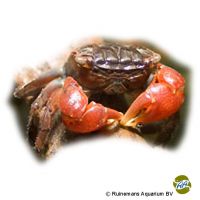Red Claw Crab (Parasesarma bidens)
| Red Claw Crab Parasesarma bidens | |
|---|---|
| Name | Red Claw Crab |
| Name Lat. | Parasesarma bidens |
| Synonym | Sesarma bidens |
| Family | Mangrove Crabs |
| Family lat. | Sesarmidae |
| Order | Decapoda |
| Order lat. | Decapoda |
| Origin | Southeast Asia |
| Habitat | Estuaries, mangrove |
| Diet | Insects, leaves, fruits, crab food |
| pH | 7.0-8.0 |
| Behavior | ♂ semi-aggressive |
| Keeping | Pair, harem |
| Care Level | Easy |
| Reproduction | Marine larval stages |
| Breeding | Difficult |
| Life Span | 3-4 years |
| Protection | No |
| Metric Units | |
| Size | 4-5 cm |
| Temperature | 20-28 °C |
| Hardness | 10-20 °dH |
| Aquarium | 50 l |
| US Units | |
| Size | 1.6"-2" |
| Temperature | 68-82 °F |
| Hardness | 178-356 ppm |
| Aquarium | 15 gal |
Distribution and habitat
The red-sided crab are widespread in the Indo-Pacific from southern Japan through Thailand, the Malay Peninsula and in Indonesia to Fiji. They live amphibiously in the intertidal zones of rivers, in mangrove swamps and on sandy beaches.
Maintenance
They need a terrarium (aquaterrarium) with a deep substrate suitable for cave building, made of non-rotting substrate such as sand-peat mixture with coconut fibers and sphagnum moss with a drainage, covered with leaves and pieces of bark. In addition, climbing branches with rough bark, branch forks in which water can collect as well as a shallow water basin
Advantageous are artificial plants as a screen, which can be easily removed for cleaning. Daily 1-2 times the terrarium must be finely sprayed with water inside (humidity), but better is a rain or fog system.
In the water tank, the water quality must correspond to that for the average keeping of freshwater fish. Regular partial water changes are required to maintain water quality. When using a filter, make sure that only a weak current is created and that no animals can be sucked in
| Temp. air: 20-28 °C | Temp. water: approx. 25 °C | Humidity: 70-90 % |
The lighting duration must be 10-14 hours depending on the season. Daylight fluorescent tubes with low UV content are very suitable, supplemented with spotlights.
Diet
They need animal and vegetable food. The food offer consists of foliage (oak, beech, sea almond tree), vegetables (peas, carrots, zucchini, etc.), fruit (apple, pear, banana, etc.) supplemented with high-quality dry food for fish, crabs and shrimps (spirulina tabs) and commercial frozen food mixtures. Occasionally, chicken meat and smelt can be offered. It is important to regularly add minerals (cuttlebone, calcium powder) and vitamins
A regular and varied diet promotes health and prevents deficiency symptoms. Unaccepted food should be removed after 4-5 hours.
Behaviour and compatibility
They are usually well tolerated within the species and should be kept in a harem or at least in pairs. Socialization with shrimps and snails is possible, but it is better to keep them in a species tank.
Basically only mutually compatible species with similar demands on water quality and water temperature should be kept together
Reproduction and breeding
The males have much larger and more colorful claws.
The females carry several thousand eggs in their abdominal pouches until the larvae hatch. The larvae live planktonically in seawater, where they go through several stages of development until they return to land as finished juvenile crabs about 5 mm in size.
Important
They can communicate with each other through gestures and tapping
Special care should be taken to cover the aquaterrarium well, as they are escape specialists. Escaped crabs dry out quickly.
The aquaterrarium must have good ventilation without drafts and meet the species specific needs. Measuring devices such as thermometers, hygrometers, etc. are necessary. The lighting must correspond to the species-specific day-night rhythm and must be installed in such a way that the animals cannot injure themselves. Contamination must be removed regularly.
Further literature can be found in your pet store.
References
Text: petdata; Image: Ruinemans Aquarium B.V.
Source: WERNER (2002): Garnelen, Krebse und Krabben im Süßwasseraquarium, Verlag ACS; ENGELMANN & LANGE (2011): Zootierhaltung - Tiere in menschlicher Obhut: Wirbellose, Verlag Harri Deutsch
